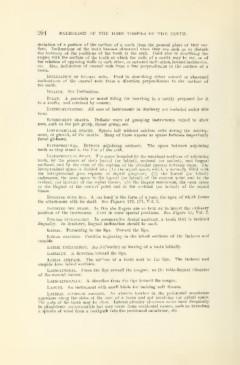Page 552 - My FlipBook
P. 552
294 PATHOLOGY OF THE HAED TISSUES OF THE TEETH.
deviation of a portion of the surface of a tooth from the general plane of that sur-
face. Inclinations of the teeth become abnormal when they are such as to disturb
the harmony of the positions of the teeth in the arch. Used also in describing the
angles with the surface of the tooth at which the walls of a cavity may be cut, or of
the relation of opposing walls to each other, as outward inclination, inward inclination,
etc. Also, inclination of enamel rods from a line perpendicular to the surface of a
tooth.
Inclination of enamel rods. Used in describing either normal or abnormal
inclinations of the enamel rods from a direction perpendicular to the surface of
the tooth.
Incline. See Inclination.
Inlay. A porcelain or metal filling for inserting in a cavity prepared for it
in a tooth; and retained by cement.
Instrumentation. All uses of instruments in dentistry are included under this
term.
Instrument grasps. Definite ways of grasping instruments suited to their
uses, such as the pen grasp, thrust grasp, etc.
Interglobular spaces. Spaces left without calcium salts during the develop-
ment, or growth, of the dentin. Many of these appear as spaces between imperfectly
fused globules.
Interproximal. Between adjoining surfaces. The space between adjoining
teeth as they stand in the line of the arch.
Inteepeosimal Space. The space bounded by the proximal surfaces of adjoining
teeth, by the planes of their buccal (or labial), occlusal (or incisal), and lingual
surfaces, and by the crest of the septum of the alveolar process between them. The
interproximal space is divided into ( 1 ) the septal space, which is normally filled with
the interproximal gum septum, or septal gingivae; (2) the buccal (or labial)
embrasure, the open space to the buccal (or labial) of the contact point and to the
occlusal (or incisal) of the septal tissue; (3) the lingual embrasure, the open space
to the lingual of the contact point and to the occlusal (or incisal) of the septal
tissue.
Inverted cone bur. A bur head in the form of a cone, the apex of which forms
the attachment with its shaft. See Figures 170, 171, Vol. 2.
Inverted pen grasp. In this the fingers are so bent as to invert the ordinary
position of the instrument. Used in some special positions. See Figure 55, Vol. 2.
Invtard inclination. In comparative dental anatomy, a tooth that is inclined
lingually. In dentistry, lingual inclination should be used.
Labial. Pertaining to the lips. Toward the lips.
Labial cavities. Cavities beginning in the labial surfaces of the incisors and
cuspids.
Labial inclination. An inclination or leaning of a tooth labially.
Labially. a direction toward the Ups.
Labial surface. The surface of a tooth next to the lips. The incisors and
cuspids have labial surfaces.
Labio-lingual. From the lips toward the tongue; as the labio-lingual diameter
of the central incisor.
Labio-lingually. a direction from the lips toward the tongue.
Lancet. An instrument with small blade for incising soft tissues.
Lateral alveolar abscess. An abscess located in the peridental membrane
anywhere along the sides of the root of a tooth and not involving the apical space.
The pulp of the tooth may be alive. Lateral alveolar abscesses occur most frequently
in phagedenic pericementitis but may occur from accidental causes, such as thrusting
a spicula of wood from a toothpick into the peridental membrane, etc.


